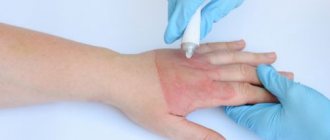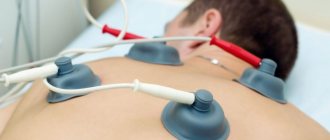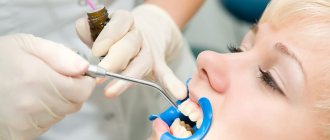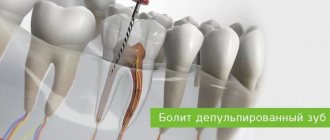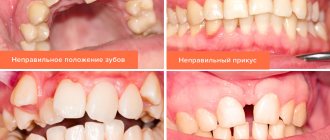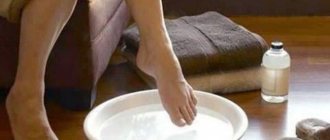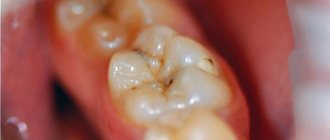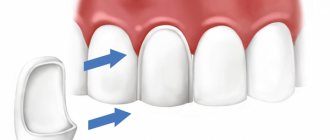Ibuklin Junior is a combination drug based on paracetamol and ibuprofen. Has complex therapeutic activity. Widely used to treat infectious and inflammatory pathologies, and also helps relieve pain and fever. Intended for oral administration to patients of various age categories.
pharmachologic effect
The therapeutic property of the drug lies in its unique composition.
Due to the content of Ibuprofen, anti-inflammatory, antipyretic and analgesic effects are noted. It suppresses the production of certain receptors, helping to reduce the production of prostaglandins, which are responsible for the development of pain, inflammation and hyperemia.
Paracetamol in Ibuklin Junior has a slight effect on the mucous surface of the digestive tract and water-salt metabolism. It has a pronounced analgesic and antipyretic effect.
The drug is characterized by a high degree of adsorption. The maximum concentration of medicinal substances is achieved 30-60 minutes after application.
Excretion is carried out primarily by the kidneys, and a small amount is excreted in bile.
Indications of Ibuklin Junior
Indications for prescribing the drug are:
- Headache.
- Some period after the operation.
- Fever.
- Inflammatory damage to the musculoskeletal system and soft tissues due to trauma.
- Arthritis, arthrosis, osteoporosis.
- Angina.
- Sinusitis.
- Pain in teeth.
- Pain in muscles and nerve endings.
- Tenosynovitis.
- Algodismenorrhea.
- Diseases of the upper respiratory tract of an inflammatory nature (laryngitis, tracheitis, pharyngitis).
Ibuklin Junior
INSTRUCTIONS for the use of the medicinal product for medical use IBUCLIN JUNIOR ®
Registration number: P N011252/02
Trade name of the drug: Ibuklin Junior®
INN or generic name of the drug: Ibuprofen + Paracetamol
Dosage form: dispersible tablets [for children]
Composition Each dispersible tablet [for children] contains: active ingredients: ibuprofen 100 mg, paracetamol 125 mg; excipients: microcrystalline cellulose 20 mg, corn starch 59.04 mg, lactose 5 mg, sodium carboxymethyl starch (type A) 30 mg, crimson dye (Ponceau 4R) (E124) 0.2 mg, glycerol 2 mg, colloidal silicon dioxide 5 mg, orange flavor DC 100 PH 1.6 mg, pineapple flavor DC 106 PH 2.5 mg, peppermint leaf oil 0.66 mg, aspartame 10 mg, magnesium stearate 1 mg, talc 3 mg.
Description Tablets are flat-cylindrical in shape, pink in color with inclusions, with a bevel and a score on one side and a fruity-mint odor.
Pharmacotherapeutic group: analgesic, combined (NSAID + analgesic non-narcotic drug).
ATX code: M01AE51
Pharmacological properties Pharmacodynamics A combined drug, the effect of which is determined by the components included in its composition. Ibuprofen is a nonsteroidal anti-inflammatory drug (NSAID) that has analgesic, anti-inflammatory, and antipyretic effects. By inhibiting cyclooxygenase (COX) 1 and 2, it disrupts the metabolism of arachidonic acid, reduces the amount of prostaglandins (mediators of pain, inflammation and hyperthermic reaction) both in the site of inflammation and in healthy tissues, suppresses the exudative and proliferative phases of inflammation. Paracetamol indiscriminately blocks COX, mainly in the central nervous system, and has little effect on water-salt metabolism and the mucous membrane of the gastrointestinal tract (GIT). Has an analgesic and antipyretic effect. In inflamed tissues, peroxidases neutralize the effect of paracetamol on COX 1 and 2, which explains the low anti-inflammatory effect. The effectiveness of the combination is higher than that of individual components. Pharmacokinetics of Ibuprofen. Absorption is high, quickly and almost completely absorbed from the gastrointestinal tract (GIT). The time to reach maximum concentration (TCmax) after oral administration is about 1-2 hours. Communication with blood plasma proteins is more than 90%. The half-life (T1/2) is about 2 hours. It slowly penetrates into the joint cavity, accumulates in the synovial fluid, creating higher concentrations in it than in the blood plasma. After absorption, about 60% of the pharmacologically inactive R-form is slowly transformed into the active S-form. Metabolized. More than 90% is excreted by the kidneys (no more than 1% unchanged) and, to a lesser extent, with bile in the form of metabolites and their conjugates. Paracetamol. Absorption is high, binding to plasma proteins is less than 10% and increases slightly with overdose. Sulfate and glucuronide metabolites do not bind to plasma proteins even at relatively high concentrations. The Cmax value is 5-20 mcg/ml, TCmax is 0.5 - 2 hours. Distributed fairly evenly in body fluids. Penetrates the blood-brain barrier. About 90 - 95% of paracetamol is metabolized in the liver to form inactive conjugates with glucuronic acid (60%), taurine (35%) and cysteine (3%), as well as a small amount of hydroxylated and deacetylated metabolites. A small part of the drug is hydroxylated by microsomal enzymes to form highly active N - acetyl - n - benzoquinone imine, which binds to the sulfhydryl groups of glutathione. When glutathione reserves in the liver are depleted (in case of overdose), the enzyme systems of hepatocytes can be blocked, leading to the development of their necrosis. T1/2 – 2-3 hours. Excreted by the kidneys, mainly in the form of glucuronide and sulfate conjugates (less than 5% unchanged). Less than 1% of the administered dose of paracetamol passes into breast milk. In children, the ability to form conjugates with glucuronic acid is lower than in adults.
Indications for use: Feverish syndrome. Pain syndrome of weak or moderate intensity of various etiologies: toothache, pain during sprains, dislocations, fractures. As an auxiliary drug for the treatment of pain and fever in sinusitis, tonsillitis, acute infectious and inflammatory diseases of the upper respiratory tract (pharyngitis, tracheitis, laryngitis).
Contraindications Increased individual sensitivity to the components of the drug (including other NSAIDs), peptic ulcer of the stomach and duodenum in the acute phase, complete or incomplete combination of bronchial asthma, recurrent polyposis of the nose and paranasal sinuses and intolerance to acetylsalicylic acid or other NSAIDs (including history), severe renal failure (creatinine clearance less than 30 ml/min), optic nerve damage, genetic absence of glucose - 6 - phosphate dehydrogenase, diseases of the blood system, the period after coronary artery bypass surgery, progressive kidney disease, severe liver failure or active liver disease, confirmed hyperkalemia, active gastrointestinal bleeding, inflammatory bowel diseases, children (up to 3 years).
Method of administration and dosage regimen The drug is taken orally. Before use, the Ibuklin Junior® tablet should be dissolved in 5 ml (1 teaspoon) of water. The daily dose of the drug is taken in 2-3 doses. The minimum time interval between taking the drug is 4 hours. Children over 3 years old. Single dose – 1 tablet. The daily dose depends on the age and weight of the child: 3-6 years (13-20 kg) - 3 tablets per day; 6-12 years (20-40 kg) - up to 6 tablets per day. In case of impaired renal or liver function, the interval between doses of the drug should be at least 8 hours. The drug should not be taken for more than 5 days as an analgesic and for more than 3 days as an antipyretic without medical supervision.
Precautions for use : Chronic heart failure, cerebrovascular disease, dyslipidemia/hyperlipidemia, diabetes mellitus, peripheral arterial disease, smoking, creatinine clearance less than 60 ml/min, history of ulcerative lesions of the gastrointestinal tract, presence of Helicobacter pylori infection, long-term use of NSAIDs, alcoholism , severe somatic diseases, simultaneous use of oral glucocorticosteroids (including prednisolone), anticoagulants (including warfarin), antiplatelet agents (including acetylsalicylic acid, clopidogrel), selective serotonin reuptake inhibitors (including citalopram, fluoxetine, paroxetine, sertraline).
Use during pregnancy and lactation If it is necessary to use the drug Ibuklin Junior® during pregnancy and lactation (breastfeeding), you should carefully weigh the expected benefits of therapy for the mother and the potential risk for the fetus or child. If it is necessary to use it in the first trimester of pregnancy, long-term use of the drug Ibuklin Junior should be avoided. If short-term use of the drug Ibuklin Junior® is necessary during lactation, cessation of breastfeeding is usually not required. Experimental studies have not established the embryotoxic, teratogenic and mutagenic effects of the components of the drug Ibuklin Junior®.
Symptoms of overdose, measures to assist in case of overdose Symptoms: gastrointestinal disorders (abdominal pain, diarrhea, nausea, vomiting, anorexia, epigastric pain), increased prothrombin time, bleeding after 12 - 48 hours, lethargy, drowsiness, depression, headache, tinnitus, impaired consciousness, heart rhythm disturbances, decreased blood pressure, manifestations of hepato- and nephrotoxicity, convulsions, possible development of hepatonecrosis. Treatment: gastric lavage during the first 4 hours; alkaline drinking, forced diuresis; activated carbon orally, administration of SH-group donors and precursors for the synthesis of glutathione - methionine 8-9 hours after an overdose and N-acetylcysteine orally or intravenously - after 12 hours, antacid drugs; hemodialysis; symptomatic therapy. The need for additional therapeutic measures (further administration of methionine, intravenous administration of N-acetylcysteine) is determined depending on the concentration of paracetamol in the blood, as well as the time elapsed after its administration.
Possible side effects when using the drug In therapeutic doses, the drug is usually well tolerated. From the digestive system: rarely - dyspeptic symptoms, with long-term use in high doses - hepatotoxic effect. From the hematopoietic system: rarely - thrombocytopenia, leukopenia, pancytopenia, neutropenia, agranulocytosis. Allergic reactions: rarely - skin rash, itching, urticaria. If side effects occur, you should stop taking the drug and consult a doctor.
Interaction with other drugs and (or) food products When using the drug Ibuklin Junior® simultaneously with drugs, various interaction effects may develop. Long-term combined use with paracetamol increases the risk of nephrotoxic effects. Combination with ethanol, glucocorticosteroids, corticotropin increases the risk of erosive and ulcerative lesions of the gastrointestinal tract. Ibuprofen enhances the effect of direct (heparin) and indirect (coumarin and indanedione derivatives) anticoagulants, thrombolytic agents (alteplase, anistreplase, streptokinase, urokinase), antiplatelet agents, colchicine - the risk of developing hemorrhagic complications increases. Enhances the hypoglycemic effect of insulin and oral hypoglycemic drugs. Weakens the effects of antihypertensive drugs and diuretics (by inhibiting the synthesis of renal prostaglandins). Increases the blood concentration of digoxin, lithium and methotrexate. Caffeine enhances the analgesic effect of ibuprofen. Cyclosporine and gold preparations increase nephrotoxicity. Cefamandole, cefoperazone, cefotetan, valproic acid, plicamycin increase the incidence of hypoprothrombinemia. Antacids and cholestyramine reduce the absorption of the drug. Myelotoxic drugs contribute to the manifestation of hematotoxicity of the drug.
Special instructions The advisability of using the drug as an antipyretic is decided in each case, depending on the severity, nature and tolerability of the febrile syndrome. Ibuprofen may mask objective signs of infectious diseases, so ibuprofen therapy in patients with infectious diseases should be prescribed with caution. To reduce the risk of developing adverse events from the gastrointestinal tract, the minimum effective dose should be used for the shortest possible short course. With the simultaneous use of indirect anticoagulants, it is necessary to monitor the indicators of the blood coagulation system. Co-administration of Ibuklin Junior with other NSAIDs should be avoided. With long-term (more than 5 days) use of the drug, monitoring of peripheral blood and the functional state of the liver is necessary. The drug may distort the results of laboratory tests when quantitatively determining glucose, uric acid in blood serum, and 17-ketosteroids (the drug must be discontinued 48 hours before the test).
Impact on the ability to drive vehicles and machinery During the treatment period, the patient should refrain from engaging in potentially hazardous activities that require increased attention and speed of psychomotor reactions.
Release form Dispersible tablets [for children] 100 mg + 125 mg. 10 tablets per PVC/Al blister. 1, 2 or 20 blisters along with instructions for use in a cardboard pack.
Storage conditions : Protected from light at a temperature not exceeding 25 °C. Keep out of the reach of children!
Shelf life: 5 years. Do not use after the expiration date stated on the packaging.
Conditions for dispensing from pharmacies By prescription.
Manufacturer Dr. Reddy's Laboratories Ltd., India Dr. Reddy's Laboratories Ltd., India
Address of production place 1. Unit-1, Plot No. 137, 138 & 146, SV Co-op. Industrial Estate, Bollaram, Jinnaram Mandal, Medak District, Telangana State, India 2. Khol, Nalagarh Road, Baddi, Dist. Solan, Himachal Pradesh, India.
Information about complaints and adverse drug reactions should be sent to the following address: Representative office: 115035, Moscow, Ovchinnikovskaya embankment, 20, building 1 tel. fax
Contraindications
Absolute contraindications to the use of the drug are:
- Severe pathologies of the cardiovascular system.
- History of liver disease.
- Hyperkalemia.
- Intolerance to the components of the drug.
- Ulcerative lesions of the gastrointestinal tract.
- Kidney pathology.
- Liver failure.
- Children under 2 years of age.
- Lactation.
- Pregnancy.
- Bronchial asthma.
With extreme caution, the medicine is prescribed to persons with gastritis, enteritis, gastrointestinal ulcers, hypertension, and impaired renal and liver function. Also, according to extreme indications, Ibuklin Junior is used for heart failure, diabetes mellitus, in the 2-3 trimesters of pregnancy, in old age and blood diseases.
Complications in the treatment of acute pulpitis
In some cases, as a result of treatment of acute pulpitis, the patient develops complications. Severe pain or increased sensitivity occurs when:
- biting hard food, chewing rough food;
- pressing on the tooth;
- exposure to cold water.
In such cases, the doctor prescribes treatment of the tooth with an anesthetic solution or a course of physiotherapy in the form of obtaining fluctuating currents. In case of relapses, it is recommended to replace the medication that was placed in the dental cavity during treatment. If such procedures are not effective, the affected tooth may be removed.
If treatment of acute pulpitis is required, the price depends on a number of factors. The final cost is influenced by the quality of the consumables used, medications, types of material for filling, as well as the equipment used. Dental clinics have a standard price list that indicates how much each procedure costs.
Side effects
The medicine is considered quite toxic and can cause a wide range of side effects. The most common of them are:
- Dyspeptic disorders - vomiting, nausea, abdominal pain, bowel dysfunction, flatulence.
- Development of symptoms of hepatitis and pancreatitis.
- Dry mouth.
- Dizziness and headache.
- Insomnia and drowsiness.
- Anxiety, irritability, excitement, depression.
- Tachycardia, increased blood pressure.
- Shortness of breath, even at rest, bronchospasm.
- Allergic manifestations - rash and dry skin, itching, hyperemia, swelling. Possible urticaria, Quincke's edema.
Less commonly, hyperhidrosis, hallucinations, meningitis, and changes in laboratory blood parameters may occur after taking the drug.
Instructions for use
Ibuklin Junior is allowed to be taken by patients over 2 years of age. The dosage and duration of therapy is determined by the doctor according to the diagnosis and age of the patient.
The drug is used according to the following scheme:
- children 3-6 years old - 1 tablet 3 times a day;
- children 6-12 years old - no more than 5 tablets per day;
- over 12 years old - up to 7 tablets are prescribed.
The drug should be taken before meals or 2-3 hours after a meal.
If the liver and kidneys are impaired, patients need to adjust the therapeutic dose.
For small children, for convenience, the tablet can be dissolved in a small amount of water.
The duration of the course should not exceed 5 days. Otherwise there may be negative consequences.
Ibuklin® (Ibuclin)
With the simultaneous use of Ibuklin® with drugs, various interaction effects may develop.
When taken simultaneously with acetylsalicylic acid, ibuprofen reduces its anti-inflammatory and antiaggregation effect (an increase in the incidence of acute coronary insufficiency in patients receiving small doses of acetylsalicylic acid as an antiaggregation agent is possible after the start of administration).
Combination with ethanol, glucocorticosteroids, corticotropin increases the risk of erosive and ulcerative lesions of the gastrointestinal tract.
Ibuprofen enhances the effect of direct (heparin) and indirect (coumarin and indanedione derivatives) anticoagulants, thrombolytic agents (alteplase, anistreplase, streptokinase, urokinase), antiplatelet agents, colchicine - the risk of developing hemorrhagic complications increases.
Enhances the hypoglycemic effect of insulin and oral hypoglycemic drugs.
Weakens the effects of antihypertensive drugs and diuretics (by inhibiting the synthesis of renal prostaglandins).
Increases the blood concentration of digoxin, lithium and methotrexate.
Caffeine enhances the analgesic effect of ibuprofen.
Cyclosporine and gold preparations increase nephrotoxicity.
Cefamandole, cefoperazone, cefotetan, valproic acid, plicamycin increase the incidence of hypoprothrombinemia.
Quinolone antibiotics: In patients receiving concomitant treatment with NSAIDs and quinolone antibiotics, the risk of seizures may be increased. Antacids and cholestyramine reduce the absorption of the drug.
Myelotoxic drugs contribute to the manifestation of hematotoxicity of the drug.
Mifepristone: NSAIDs should be started no earlier than 8-12 days after taking mifepristone. since NSAIDs may reduce the effectiveness of mifepristone.
Tacrolimus: Concomitant use of NSAIDs and tacrolimus may increase the risk of nephrotoxicity.
Zidovudine: Concomitant use of NSAIDs and zidovudine may result in increased hematotoxicity. There is evidence of an increased risk of hemarthrosis and hematomas in HIV-positive patients with hemophilia who received concomitant treatment with zidovudine and ibuprofen.
Drugs that block tubular secretion: decreased excretion and increased plasma concentrations of ibuprofen.
Inducers of microsomal oxidation (phenytoin, ethanol, barbiturates, rifampicin, phenylbutazone, tricyclic antidepressants): increased production of hydroxylated active metabolites, increased risk of developing severe intoxications.
Microsomal oxidation inhibitors: reducing the risk of hepatotoxicity. Uricosuric drugs: decreased effectiveness of drugs.
If you are using the above or other medications (including over-the-counter medications), consult your doctor before using Ibuklin®.
special instructions
The medicine must not be combined with non-steroidal anti-inflammatory drugs.
In case of simultaneous use with anticoagulants, it is important to monitor blood counts.
To exclude a bad effect on the liver, you should not drink alcohol during the course of therapy.
While taking Ibuklin Junior, you should refrain from personal driving and work that requires increased attention.
Dose adjustment is necessary for disorders of the liver, kidneys, severe pathologies of the heart, blood and in old age.
Treatment of acute pulpitis
Treatment goals:
- stop a pain attack;
- eliminate inflammation and stop the infectious process;
- restore the anatomical shape of the tooth.
When dealing with acute pain, the patient is prescribed painkillers to reduce pain until the dental appointment.
The disease is treated in two main ways - conservative or biological and surgical. In both, therapy is carried out with preliminary anesthesia. The injection is given approximately 30 minutes before the start of treatment. For anesthesia, a solution of lidocaine or trimecaine is most often used.
Conservative method of treating acute pulpitis
The main goal is pulp preservation. The doctor conducts step-by-step treatment:
- gives an injection for pain relief;
- removes necrotic dentin;
- opens the tooth cavity;
- treats with antimicrobial agents;
- lays down medicine;
- puts a filling.
Conservative therapy is carried out mainly in young patients. This method requires mandatory consideration of the presence of diseases of the oral mucosa, as well as the localization of caries.
During treatment, anti-inflammatory drugs are used - Calcidont, Dical. Preparations containing calcium hydroxide are necessary to stimulate dentin formation. Proteolytic enzymes are necessary for tissue regeneration and swelling removal. After placing the medicine, the dentist closes the tooth cavity for several days - from 3 to 5. Next, if there is no reaction of the pulp, a permanent filling is placed.
Operative or surgical method
The doctor carries out the following stages of treatment:
- Provides first aid for acute pain.
- Gives an injection for pain relief.
- Opens the dental cavity.
- Removes pulp.
- Treats the cavity with an antiseptic.
- Puts in medicine.
- Installs a seal.
This method is used to treat acute diffuse pulpitis. If acute focal pulpitis is diagnosed, treatment involves removing the ostial and coronal pulp, while preserving the root pulp.
Surgical treatment is carried out in one or two visits.
For surgical treatment in one visit, the order is as follows:
- The doctor administers anesthesia and removes necrotic tissue.
- Using instruments, the tooth is filled with a non-toxic material.
When undergoing surgical treatment in two rooms, the procedure has a different procedure:
- First, the dentist applies arsenic or a devitalizing paste containing arsenic to the affected area of the tooth. This is necessary to kill the inflamed nerve. The duration of installation of arsenic on a diseased tooth is 24 hours on a single-root tooth, up to 48 hours on a multi-root tooth. Some types of pastes can be left for a long time - up to 7 - 15 days.
- A tampon with an anesthetic is placed in the canal and a temporary filling is placed. The patient is sent home.
- At the second visit to the dentist, the doctor extracts the arsenic or paste, completely removes the pulp and fills the tooth cavity.
The surgical treatment process is always monitored by radiography.
